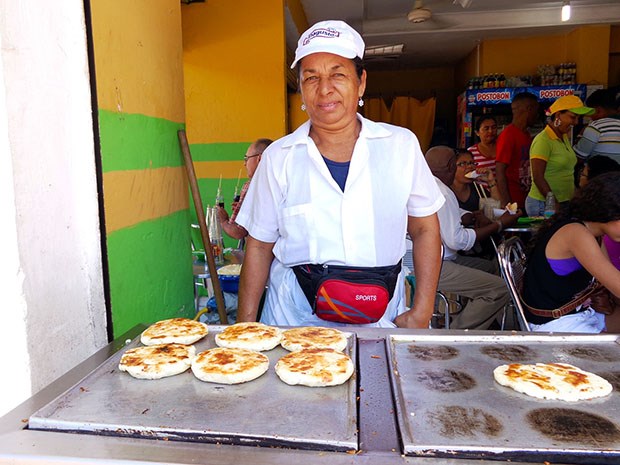A blast of warm air welcomes us as we deplane at Cartagena Airport.
With Christmas only days away, the Colombian city’s streets are busy with merry local shoppers. Next to our Stil Hotel is a small outdoor bar where men with cold cervasas sit on dozens of plastic chairs. A stone’s throw away women rummage through the best display of running shoes — knock-offs of every major brand — ever seen spread on concrete.
Onward for blocks sidewalks are laid with electronics, DVDs of the latest Hollywood blockbusters, toys and all manner of gift items. Fresh fruit and savoury food carts feed the masses.
My husband Rick and I veer towards the Arepas con Queso stand — not caring if these delectable fried cakes of ground maize stuffed with melted salty cheese are turning our middles Santa-rotund.
We stockpile them for our Christmas Eve feast, along with chicken and potatoes roasted together in a divine herb sauce, a fruit-laden cake and mucho vino.
We make our way daily to the walled Old Town. The moment we step through the stately Puerta del Reloj (Clock Gate) it is like a gathering of the United Nations. Cruise ships come into port daily and passengers are transported by bus or taxi to this enclave to spend the day.
The bustle is electric. Hawkers sell hats, T-shirts, cigars and jewelry. Entertainers perform by the outdoor restaurant tables for pesos and we cringe watching a juggler tossing machetes.
Cartagena was founded in 1533, swiftly becoming the main Spanish port on the Caribbean coast. It was the place where gold and emeralds, plundered from the indigenous peoples, were stored until galleons could ship them back to Spain.
These treasures made this port a target for British and French pirates, so after several sieges, the elaborate walls went up. Most of them are intact today.
The Old Town’s fine old colonial houses, now turned into restaurants and emerald shops, still emit an aura of their dark history. Plaza de los Coches was once a slave market. Further along is San Pedro Claver Square, with a church and convent dedicated to Jesuit monk Pedro Claver, who spent his life helping the slaves. We’re mesmerised at seeing his remains in a glass coffin in the altar of the church.
Facing us while sitting on a bench at Plaza de Bolívar is the Palace of the Inquisition — once a prison with torture chambers and ghastly devices to squeeze confessions from those convicted of heresy against the Catholic faith.
We next step into the Gold Museum filled with pre-Hispanic gold objects from the burial mounds of the Sinú culture, which somehow survived the conquistador pillage.
On a lighter note, we stop and listen to Christmas carols spilling from the open doors of Santa Domingo church. Outside this church no one misses taking a gander at the sizable bronze female lying on her side, donated by Colombia’s world-renowned artist/sculptor Fernando Botero. He is known for his voluminous exaggerated human forms that represent political criticism or humour, depending on the piece.
Cartagena is a city in which to walk everywhere. One of our ventures is to Castillo San Felipe de Barajas, the huge stone fortress built by the Spanish in 1639, and re-built after each of several attacks. Its complex system of tunnels is eerily fascinating. As we manoeuvre the inclines, declines, corners and straightaways, we learn these passageways for bringing in supplies and troop changes also incorporated defensive strategies — the echo of the chambers are geared to hearing footsteps of the enemy and some passages end in a trap.
For a change of pace, a day on Bocagrande beach is heavenly. Swimming in the tepid Caribbean is no problem for us amateurs as stone breakwaters slow down the thrashing waves.
Cartagena turns us into nighthawks as we don’t want to miss its glittering buildings and sparkling Christmas trees. On our last night, we watch a fireworks display from our hotel window, an extravaganza that, as well as ringing in the New Year, we consider to be our send-off.
Travel Writers’ Tales is an independent travel article syndicate that offers professionally written travel articles to newspaper editors and publishers. To check out more, visit www.travelwriterstales.com.



